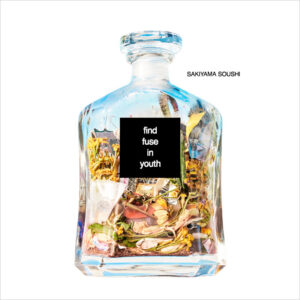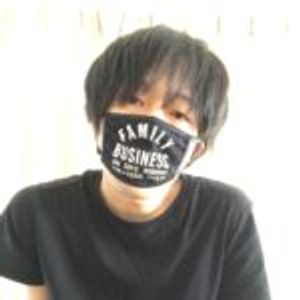Soushi Sakiyama has announced the release of his anticipated major debut album, find fuse in youth. In 2018, Sakiyama made an appearance on the internet show and marveled the Japanese music scene with his adept guitar playing and dainty crooning. His latest work articulates his potentials that have not been unveiled yet. The most surprising thing in the album is the numbers of electronic tracks he had programmed by himself. The songs with hyper pop and industrial hip-hop approach, not only show that he is an authentic singer/songwriter, but prove unequivocally that he is a cutting-edge sound creator. An 18-year-old man is leaving the album, find fuse in youth, on his final academic year. We spoke with Sakiyama to learn more about his latest creation.

The past unplugged songs “reformulated” into full band arrangements
――The album contains the rearranged versions of your past songs. All these songs are originally known as acoustic songs, but were you considering on making them into band arrangements from before?
Soushi Sakiyama (from hereunder, “Sakiyama”): The three songs I’ve included in the album as “reformulated songs” were all written while I was in middle school; at that time, I had wanted to be in a band and wrote the songs intending to be performed with a band—I was imagining a three-piece alternative rock band. However, as these three songs were written so long ago, a part of me felt detached from them. Yet this time, I was given an opportunity to reconstruct the songs with different arrangers, which made me think that these songs might become interesting.
――So, regarding the rearrangements of the past songs, you gave all the work to the arrangers?
Sakiyama: Yes, for the most part. I had conveyed my ideas, such as putting the accentuated short notes of “da-da-da!” at the 4th melody of “Samidare,” by using GarageBand, but the rest was all done by Kouhei Munemoto, who was the arranger of the song.
――How about “Heaven”? This song is garnished with a solid band-sound akin to the modern mainstream rock.
Sakiyama: The arrangement of “Heaven” is mostly done by the arranger, Ryo Eguchi. I wrote the song in my second year of middle school, when I was into all sorts of anime like Evangelion. I was elated to put the song written in that time of my life, in the hands of the person who arranged (LiSA’s) “Gurenge.”
――I heard that the song, “Undulation” which is used for the ending song of a TV anime series, was also written long ago.
Sakiyama: That’s right. I wrote “Undulation” in my final year of middle school, when I was about the same age as the anime character—so maybe my inner conflicts at that time reflected in the song was a perfect fit for the anime. It was the same with “Tadaimato Ieba” (the theme song of the movie, Town Without Sea)—It was easier for me to write the song as I was the same age as the protagonist of the film.
Self-made electronic tracks that have been inspired by artists such as JPEGMAFIA
――Along the band-sounds, there are electronic tracks in the album that are mostly made digitally. And I heard these songs are, in fact, arranged by yourself.
Sakiyama: For this album, there are 6 songs reconstructed by the arrangers, and the rest of the 7 songs are arranged by me. I would say, the ones that are clumsy sounding are done by me. [laughs]

――Among others, “waterfall in me” was especially profound. The stirring trap sound suddenly shifts into an industrial beat—the transitions in the track are quite dramatic.
Sakiyama: I wrote “waterfall in me” focusing a lot on my passion. I’ve insistently put all my current aspirations in the song.
――What are your current aspirations?
Sakiyama: In general, I’ve been obsessed with hip-hop. I was especially inspired by JPEGMAFIA among others. His song, “BALD!” was quite significant, and influenced me to try something similar. So, I made all the beats with GarageBand, plugged a mic to my iPad to record myself singing, and gave the finished data to the mixing engineer, Ayaka Toki—That was the overall flow of the production.
――“Me Wo Tojite, Userukara.” was another song with an extreme experimental approach. Its dirty sound image reminds me of music like Death Grips.
Sakiyama: Wow, I appreciate that comment. Essentially, I was trying to make a song like Charlie XCX’s, but it didn’t work out. So, I changed the style while I was making the song, and it culminated with that sound. I was like, “Why not put a lot of eerie sounds like the Death Grips’ song, ‘year of the snich!’” [laughs]
――In “waterfall in me” and “Me Wo Tojite, Userukara,” it’s interesting how the guitar wasn’t making much sound, especially because we have an image of you with the guitar—maybe your current curiosity is reflected in these songs as well.
Sakiyama: I think so. But nowadays, I’m back in the mood to play the guitar again. When I listen to a lot of music, exploring some new tunes through streaming services and YouTube, I get lost and forget what I genuinely like; yet through the process, I’ve recently rekindled my love for guitar sounds. I’m often curious to know what guitar models and gears my favorite artists are using—No doubt, the guitar is an incredibly mesmerizing instrument.
――What type of guitar sound are you attracted to recently?
Sakiyama: The last song I wrote in the album was “Kansatsu,” and I was obsessed with Jazz guitarists when I wrote the interlude of the song. Also last year, I bought a 1973 Gibson SG Special, since I’ve always been inspired by its sound; I probably got into jazz because of that guitar.
The meaning behind the ubiquitous “bird” motif in his works, and about his future
――In this album, the musicality of each song is different, and the chaotic flow is thrilling—How did you select the 13 songs?
Sakiyama: I’m 18 years-old now, and planning on leaving my hometown this spring, so I wanted to garner all the songs I wrote in my youth and combine them into one. I’ve decided to put all the songs that represent my youth—including the three “reformulated” songs, “Torini Nari Umiwo Wataru,” which I wrote during my freshman year of high school, and the types of music I want to do now—into this album.
――I’ve noticed you often mention “bird” in your lyrics. What does it symbolize to you?
Sakiyama: That’s true, I tend to write “bird” in my lyrics. [laughs] I also use the word in the lyrics of the title track, “find fuse in youth.” What does a bird symbolize to me…I guess, ‘freedom.’ When I wrote, “Torini Nari Umiwo Wataru,” I may have had the sentiment of wanting to be emancipated from various things and fly away like a bird. Also, you see birds living close to humans—if you look up the sky, you will see them flying, and even right now, they are in my sight. But even though they live in the sphere of human lives, they are independent of our society. I think that’s another reason why they are such an imperative symbol to me.
――You’ve mentioned earlier that you are moving out of your hometown this spring—what are the things you want to achieve in your future?
Sakiyama: Although it would still be difficult, I want to start a band. I’m not going to college and we are living in the era where anything could be done remotely, but I’ve decided to leave my hometown because I feel like there are still many things that can’t be achieved from where I live. I also want to experience living alone, but you know, I could always come back if I want to.
*
Soushi Sakiyama
Sakiyama is born in 2002 and currently based in Hamamatsu-city, Shizuoka. He became widely known through his appearance on an internet show on May 2018. Recently, his works have been used as theme songs for TV drama series, films, and TV commercials, however not limited to these achievements, he is also being extoled in the world of literary art with his unique linguistic representations. He receives a lot of offers from big music festivals such as FUJI ROCK FESTIVAL, SUMMER SONIC, and RISING SUN ROCK FESTIVAL. He made his major debut with the album, find fuse in youth, that has released on January 27th, 2021.
https://sakiyamasoushi.com
Twitter: @soushiclub
Translation Ai Kaneda

